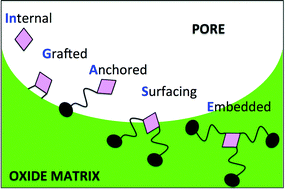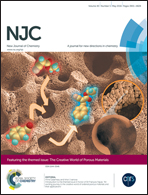Surface molecular engineering in the confined space of templated porous silica
Abstract
Advanced materials for molecular sensing, selective adsorption and heterogeneous catalysis require fine control at the surface–fluid interface. To achieve this objective several aspects of the material have to be considered: (i) the molecular structure of the active sites, (ii) their vicinity at the nanometer scale of length, (iii) their distribution in the solid and (iv) the confinement controlled by the size and shape of pores. The approaches developed to synthesise such materials are reviewed here considering mainly mesoporous templated silicas such as MCM-41, SBA-15 and related materials. In addition, a new nomenclature (InGASE) is proposed to classify hybrid or non-hybrid materials depending on the location of the function in the porous solid support and the nature of the linker. Special attention is devoted to the different strategies described in the literature to control the grafting or anchoring of organic functions and metal complexes. The challenge is to obtain isolated and well-defined unique sites in a confined nanometric space with an appropriate environment. Applications of these materials in the fields of catalysis, adsorption, sensing and drug delivery are briefly surveyed.

- This article is part of the themed collection: The Creative World of Porous Materials

 Please wait while we load your content...
Please wait while we load your content...